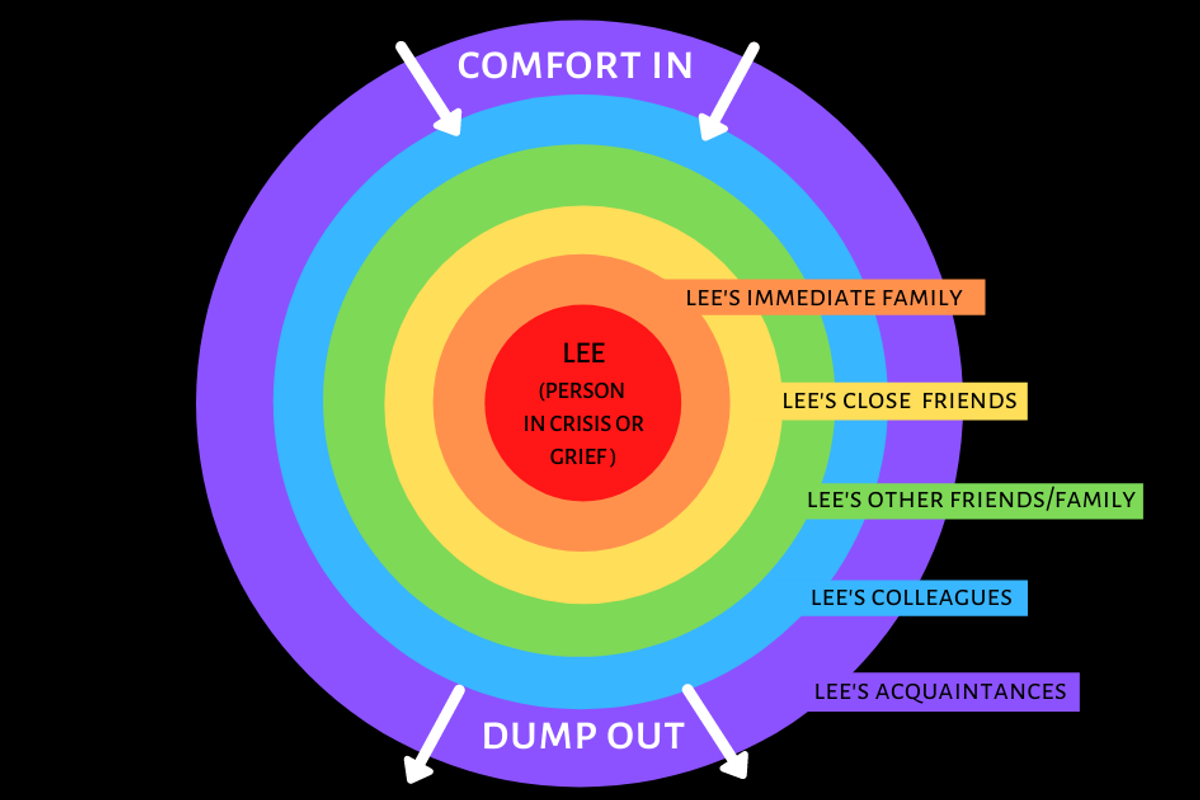Psychologist's 'Ring Theory' can help you not say the wrong thing to people in grief

It's hard to know what to say when someone you know is going through a crisis. Whether a person has lost a loved one, received a dire medical diagnosis, or is experiencing some other kind of grief, we're often at a loss for words for how to comfort them.
It gets even trickier when we share in some measure of the person's grief. When your friend finds out they have a terminal illness, that's painful for your friend and their family, but also for you. While it's important to honor that, it's also important to recognize that your grief isn't the same as the person afflicted, nor is it the same as their spouse's or children's or parents' grief. It's totally fine to feel the weight of your own sadness and loss, but there are appropriate and inappropriate places to put that weight. For example, saying to a mutual friend, "I can't handle this, it's too devastating" is very different than saying the same thing directly to your friend who just found out they are dying.
Psychologist Susan Silk has created a helpful concept that makes figuring out what to say and what not to say a bit easier. She refers to it as the Ring Theory, and she and author Barry Goldman described it in an op-ed in The Los Angeles Times.
Here's how it works:
First, draw a circle and put the name of the person in crisis in the middle of it. Then draw a ring around that and label it with the people closest to them—spouse, parents, children, etc. Then draw another ring for their intimate friends or other family members they are close to. Next, make a ring for their close co-workers, not-quite-as-close friends, distant relatives, etc., followed by a ring for other people who know them—acquaintances, community members, and such.
These concentric rings represent which direction our words of comfort and empathy should go, and which direction the venting or dumping of our own feelings of grief should go.
The person in the center can say anything they want to anyone, of course. The crisis is theirs and they get all the leeway and grace in how they express their feelings. People in the rings around them can vent their feelings toward people in the larger rings, but not the smaller ones. If we're talking to someone in a smaller ring than we are in, our words should only be comforting and empathetic, such as "I'm so sorry you're going through this," or "What a terrible tragedy, let me bring you a meal to make this time a little easier for you."
Silk explains that when we are talking to a person in a smaller circle from us—someone who is closer to the crisis—the goal is to help. It's appropriate not to offer advice, no matter how helpful we think we're being. It's not an appropriate direction for our personal storytelling or expressions of despair, however sincere. If we feel an impulse to do those things, we should point it outward, toward the people farther from the crisis.
We should never put people in smaller circles in a position of feeling like they need to comfort us. Comfort should move inward through the rings, not outward.
Let's imagine my friend Lee just lost her mother to cancer. I lost my much-loved mother-in-law to pancreatic cancer just six weeks after her diagnosis, but this is Lee's crisis, not mine. As a friend, I'm not going to tell her how much I miss my mother-in-law, describe in detail how hard it was to go through losing her, or go on and on about the meaning of life and death. I'm not going to say those things to her spouse, either. I might say, "I'm so sorry. Cancer really sucks, and this is such a hard thing to go through" and then offer to help watch the kids or bring over a casserole.

If I'm talking to a mutual friend or someone Lee knows peripherally, that's when I might share my own story or how Lee's mom's death is bringing up my own feelings of grief. The key is to make sure I'm pointing that emotional venting of my own toward someone in a larger circle, not a smaller one.
As Silk and Goldman explained, it's not so much what you say as whom you say it to.
"If you want to scream or cry or complain, if you want to tell someone how shocked you are or how icky you feel, or whine about how it reminds you of all the terrible things that have happened to you lately, that's fine," they wrote. "It's a perfectly normal response. Just do it to someone in a bigger ring."
"Comfort IN, dump OUT," they added.
Silk and Goldman point out that most of us intuitively know not to dump our feelings on the person in the center of the circle, but we may not be conscientious enough about how we talk to those who are close to the crisis as well. The Ring Theory visual can help us see where it's appropriate to vent and where it's not, and how best to help both those who are grieving and who are in the grieving person's orbit.
It can even help us recognize what we need most when we find ourselves at the center of the circle. All of us will be there at one time or another, and knowing where we are in the rings can help us know how to comfort one another through our grieving processes.
- 8 simple words to say when someone you love is grieving. - Upworthy ›
- A mother explains how even innocent phrases can trigger the grief ... ›
- 102 days after his wife's death, Patton Oswalt describes grief as only ... ›
- Zoom memorials highlight the ironic cruelty of trying to mourn together during the pandemic - Upworthy ›
- Read this before posting a RIP message on social media - Upworthy ›
- Man finds missing engagement ring after tornado hits house - Upworthy ›
- A question about strangers brought a moving response - Upworthy ›
- Man's phone call from deceased dad is lesson on grief - Upworthy ›
- What to say instead of 'let me know if you need anything' - Upworthy ›
- Man shares comedic video about the voice of grief inside his head - Upworthy ›
- 13 psychological breakthroughs that changed lives - Upworthy ›
- What to say instead of 'let me know if you need anything' - Upworthy ›



 TikTok · Ale
TikTok · Ale

 Phone charging.
Phone charging. bill nye chemistry GIF by NETFLIX
bill nye chemistry GIF by NETFLIX 


 A happy woman in the Netherlands.via
A happy woman in the Netherlands.via
 Thumbs up
Thumbs up  Woman in chair.
Woman in chair.